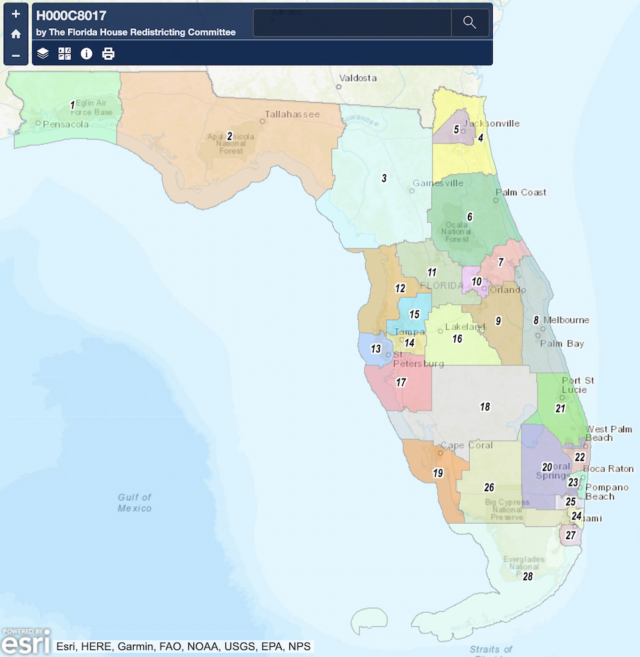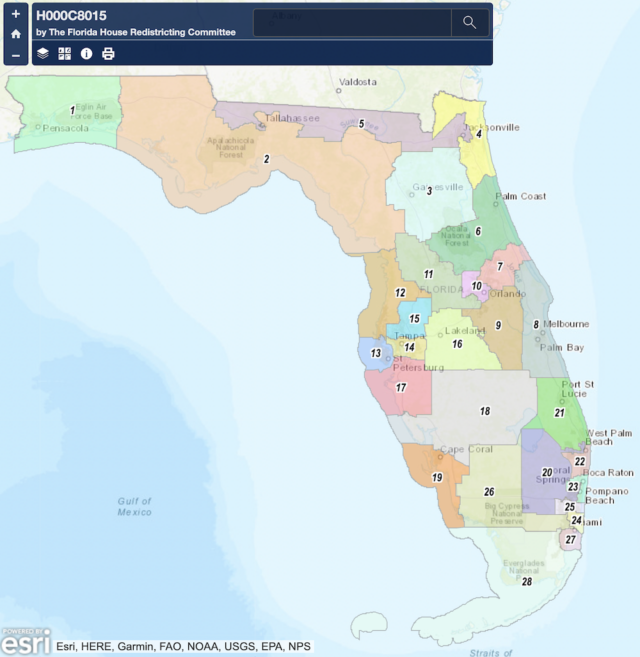
A controversial two-map proposal for Florida’s now-28 congressional districts advanced from the House Redistricting Committee.
In a never-seen effort to both address complaints from Gov. Ron DeSantis and safeguard from accusations of diminishing minority power, the committee approved both a primary map and a secondary one if the courts toss the first out. The committee voted 15-9 in favor of this approach, with Democratic Rep. Anika Omphroy joining with the majority but Republican Reps. Cord Byrd and Brad Drake voting “no.”
The primary map (H 8017) would effectively eliminate the current Florida’s 5th Congressional District, represented now by U.S. Rep. Al Lawson, a Tallahassee Democrat.
Eliminating the district follows the lead of Gov. Ron DeSantis, whose office labeled the district an “unconstitutional gerrymander” and submitted two maps that eliminated it.
But the House’s map, published the eve of the meeting, would replace the old CD 5 with a new district with a high concentration of Black voters. The proposed CD 5 would be contained within Duval County, with Blacks making up 35.27% of its voting-age population. By comparison, Blacks make up 42.6% of the existing CD 5.
Most Democrats on the committee said that presents a level of diminishment in the ability of Black voters to elect a candidate of their choice, and argued it calls the constitutionality of the map into question.
Rep. Kelly Skidmore, a Boca Raton Democrat, said she was discouraged the map even came into play — especially after Republican leadership largely shot down DeSantis’ legal arguments when Judicial Watch’s Robert Popper made them in at a subcommittee meeting last week.
“I’m kind of disappointed that our House acquiesced based on testimony that was given that it really did not have a lot of substance behind it,” she said.
But Republicans crafted legislation that takes into account the fact that the Governor’s arguments remain untested in court. An amendment filed by Rep. Tom Leek, House Redistricting Committee chair, offers a secondary map (H 8015) closer to cartography considered by the Legislature to date.
That cartography retains a configuration of a district — the new Florida’s 3rd Congressional District — that mirrors Lawson’s district. Doing so creates changes to five other jurisdictions on the map.
Rep. Tyler Sirois, House Congressional Redistricting Subcommittee chair, suggested there was little choice. “I believe that the bill that we have in front of us today is the best outcome that we could have given the information and the realities in front of us,” he said.
Sirois paused the congressional redistricting process for weeks after DeSantis submitted a proposal and then asked the Florida Supreme Court to weigh in on the legality of CD 5. The court refused to provide an opinion early.
Rep. Randy Fine, vice chair of the House Redistricting Committee, suggested it would be foolish to run any piece of legislation without taking the Governor’s opinion into account, lest risk a veto.
Skidmore said she wished the fallback map had simply been offered as the House product.
The bill now goes to the floor. But even if it passes, House leaders must come together with the Senate to agree on a final product. The Senate approved its own map (S 8060) in January, ignoring the Governor. Both House maps and the Senate map look identical south of the I-4 corridor but bear significant differences elsewhere.
In addition to the Senate map retaining a North Florida-spanning district, the House maps remake Greater Orlando and Tampa Bay.
Most notably, the maps reconfigure Florida’s 7th Congressional District, represented now by Democratic U.S. Rep. Stephanie Murphy, to shift east of Orlando and extend to the Atlantic coast.
A partisan performance analysis by MCI Maps shows a replacement for CD 7 on the Senate map remains Democratic-leaning suburban seat. But House maps convert it into one where a plurality of voters in 2020 voted for Republican Donald Trump in the last presidential election.
Both the Senate and House place Florida’s new congressional seat, awarded in a federal reapportionment process based on the 2020 Census, between Tampa and Lakeland. But the Senate map leaves that seat contained entirely in east Hillsborough County, while the House maps have a seat that straddles the Pasco and Hillsborough line. That also means it leans slightly Republican instead of slightly Democrat.
The MCI analyses show the House maps thus end up with 18 Trump-leaning districts and 10 where a majority voted for Democrat Joe Biden, albeit with three of those seats going Republican with less than 50% of the vote. The Senate map, in contrast, creates 16 Trump seats and 12 Biden-favoring jurisdictions.
Of note, the House maps became the first produced by the Legislature all year to draw “no” votes from Republicans.
Byrd took up DeSantis’ argument that using race as a predominant factor should not occur.
“The Supreme Court has held under the equal protection clause and the 15th Amendment of the Constitution that states are prohibited from using race as a predominant factor in drawing district lines unless they can show a compelling state interest,” he said.
It’s not an argument he ever leveled while chairing the House Legislative Redistricting Committee and ushered a state House map to passage. But he asserted the map that keeps the Lawson district together would generate legal trouble.
While the Florida Supreme Court implemented the current configuration of CD 5, Byrd cited a dissenting opinion in that case that called the Lawson district “concerning.”
That led to him voting “no” with most committee Democrats, albeit for a different reason. Rep. Joe Geller, ranking Democrat on the House Redistricting Committee, suggested leadership knows better. He argued Republicans wouldn’t include the fallback map in a bill if they did not suspect the primary one violates Florida’s Constitution and a requirement that the Legislature not diminish the ability for minority communities to elect a Representative of their choice.
“The notion that that map is constitutionally compliant is belied by the very fact that there is a so-called secondary map in an effort to assure constitutional compliance,” he said.
Beyond issues with the maps themselves, this committee proved among the most tense in the process to date for other reasons. Leek started the meeting by slamming a demand from Geller for a racial polarization study done for outside counsel at GrayRobinson.
While Leek acknowledged he has seen the data and that it was paid for with tax dollars, he has declined to share the findings publicly or with Democrats on the committee. He said Friday that’s because Democrats have maintained the maps were unconstitutional and expressed an intent to sue over them.
“Let’s stop the political theater. Let’s stop focusing on moving pieces across the litigation chessboard and let’s just do our work,” Leek said.
Geller denied ever claiming he or any lawmakers would sue the state over the maps, and predicted outside groups would. But he said as a member of the House, he should have the same access to any study used to craft the maps as anyone in Republican leadership.
“If the client is the House — and last time I looked, I’m still a Member of it — why is it not available to every Member?” Geller said.
Leek refused to make the data public citing “work product doctrine privilege.”






2 comments
Ron Ogden
February 26, 2022 at 9:40 am
“. . .safeguard from accusations of diminishing minority power. . .”
What is the matter with “diminishing minority power”? Minorities are minorities because they are minorities. The majority is the majority because that is what most voters want. If minorities want to run things like they are the majorities, then they have to make themselves majorities. Anything else is an inversion of the principle of democracy, and is therefore ridiculous. We have been putting up with this ridiculous situation for more than half a century because so many of us are weak-minded. sheep.
Trevor Morris
March 1, 2022 at 4:14 am
Wow, do you not know the meaning of words in the English language? “. . .safeguard from accusations of diminishing minority power. . .” has nothing to do with minorities running things like they are majorities. The two statements that you took the liberty to equate mean completely different things. Do sheep understand English? Don’t worry man minorities will still be getting screwed in Florida. If Florida’s districts designed to elect black members were proportional to their population they would have five districts. They have four. Hispanic Floridians would have seven districts, but they also only have four. Chill out man, no one is going to take away your White Power and privilage, at least not this decade
Comments are closed.